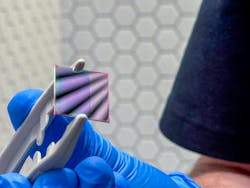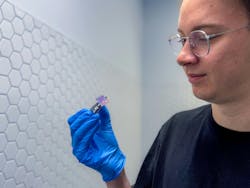Molecular triplets extend the energy storage lifetime of Dicke quantum batteries
Quantum batteries are a theoretical concept that emerged from research in quantum science and technology. Unlike traditional batteries, which rely on chemical reactions, quantum batteries aim to use superposition and interactions between electrons and light to achieve faster charging times and potentially enhanced storage capacity.
The Dicke model, which describes the collective interaction between multiple two-level systems—for example, atoms or fluorescent molecules—and the electromagnetic field of a common cavity, may offer a viable approach to developing quantum batteries. Interestingly, this model can be achieved by embedding fluorescent organic molecules into a polymer matrix placed inside an optical microcavity.
The physics of the Dicke model has been well known since the 1970s for its celebrated phenomenon of superradiance, which describes a rapid burst of energy whose power scales with the concentration of emitters in a cavity. But the idea of using a Dicke system to achieve “superabsorption” is more recent, and it was only recently suggested to achieve scalable charging power for a solid-state battery quantum battery.1
This idea led to the first experimental test of a “Dicke” quantum battery,2 which showcased femtosecond charging times and charging power that scales superextensively with the number of emitters within the cavity. One downside is that these devices rapidly lose energy within nanoseconds, primarily due to radiative losses, which are exacerbated by the well-known Dicke superradiance.
Preventing radiative relaxation with molecular triplets
At RMIT University in Australia, we developed an innovative idea to prevent this rapid self-discharge problem. It’s based on exploiting the longer lifetime of molecular triplet states, which are optically dark and don’t couple strongly with the electromagnetic field of the cavity. While triplets only live for microseconds (not enough for use in everyday electronics), they offer a promising first step toward prolonged energy storage.
To implement our idea, we designed and fabricated five multilayer microcavity devices the size of a stamp, each comprising an active absorption layer coupled to a storage layer rich in molecules capable of forming a triplet state. By tuning the energy levels of molecules and the cavity, we aimed to achieve resonance between the lower polariton states and the triplet states. This facilitates the rapid and efficient energy transfer from bright polaritons, which are ideal for superabsorption, and the dark triplets, which would effectively store the energy.
Device design and fabrication
Aligning the energy levels of the polaritons and the energy storage molecules is achieved by carefully adjusting the size of the optical cavity, which was precisely modeled for these experiments. This tuning allows us to bring the relevant energies into resonance and enhances the interaction between light and matter inside the device. To create these cavities, we fabricate thin layers of polymer and sandwich them between reflective coatings. The fabrication techniques we use are common within the broader field of electronics manufacturing, which suggests this technology could be adapted for large-scale production in the future.
The process begins with a polished silicon wafer, chosen for its extremely smooth surface, which provides an ideal foundation for building the device. Onto this, we deposit a fully reflective silver mirror using electron beam evaporation, with a very thin chromium layer to help it adhere to the surface. We then apply polymers using spin-coating techniques, which involve spreading a liquid solution across the wafer and spinning it at high speed to form uniform thin films. These polymer layers form the main structure of the device and include the embedded functional molecules.
The first layer contains the storage molecules that are responsible for capturing and holding the energy. Next, we add a spacer layer that physically separates the storage and charging layers to prevent any unwanted interactions that could bypass the desired polariton-mediated energy transfer process. The final polymer layer contains the charging molecules. To complete the device, we add a semitransparent silver mirror, which defines the cavity and allows light to enter and exit, and enables us to study the behavior of the system.
We fabricate five different versions of the device, each with a different cavity length, to explore and optimize the energy alignment for improved performance.
1,000-fold energy lifetime enhancement
Our experiments revealed that when the energy of the lower polariton matched that of the triplet state, the device exhibited optimal energy storage performance. Specifically, one of our devices achieved an energy storage duration of approximately 40 µs—marking a 1,000-fold improvement over previous demonstrations, which were limited to nanosecond timescales.
This significant enhancement underscores the potential of molecular triplet states for mitigating rapid energy loss in quantum batteries. While the achieved storage lifetime is still brief in absolute terms, it represents a substantial leap forward in the quest for practical quantum batteries.
Challenges and opportunities
Our findings lay the groundwork for future research aimed at further extending storage times, enhancing energy densities, and exploring real-world applications. The challenges that must be overcome are energy storage times and work extraction methods. Researchers are now addressing these issues3 to achieve energy storage of the order of hours and eventually days or longer. These goals might be achieved by forming charge-separated states.4 This could enable Dicke quantum batteries to power small, low-power electronic devices, such as wearable sensors and microprocessors.
FURTHER READING
D. J. Tibben et al., PRX Energy, 4, 023012 (Jun. 23, 2025); https://doi.org/10.1103/bhyh-53np.
REFERENCES
- D. Ferraro, M. Campisi, G. M. Andolina, V. Pellegrini, and M. Polini, Phys. Rev. Lett., 120, 117702 (Mar. 15, 2018); https://doi.org/10.1103/physrevlett.120.117702.
- J. Q. Quach et al., Sci. Adv., 8, 2 (Jan. 14, 2022); https://doi.org/10.1126/sciadv.abk3160.
- F. Campaioli et al., Rev. Mod. Phys., 96, 031001 (Jul. 9, 2024); https://doi.org/10.1103/revmodphys.96.031001.
- K. Hymas et al., Pre-Print, arXiv:2501.16541 (Jan. 27, 2025); https://doi.org/10.48550/arXiv.2501.16541.
About the Author
Francesco Campaioli
Francesco Campaioli is a theoretical physicist and Vice Chancellor’s Research Fellow at the Royal Melbourne Institute of Technology (RMIT; Melbourne, VIC, Australia).
Daniel Tibben
Daniel Tibben is a Ph.D. candidate under the supervision of Professor Daniel Gómez at the Royal Melbourne Institute of Technology (RMIT; Melbourne, VIC, Australia).

